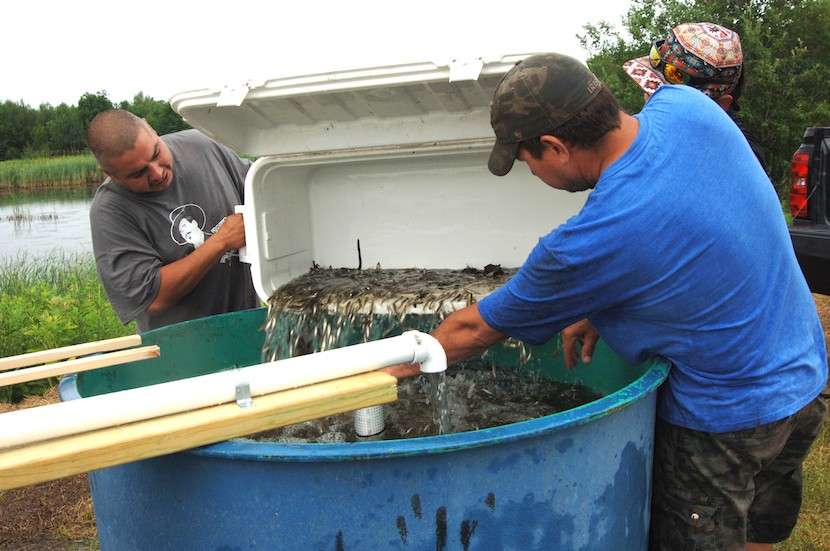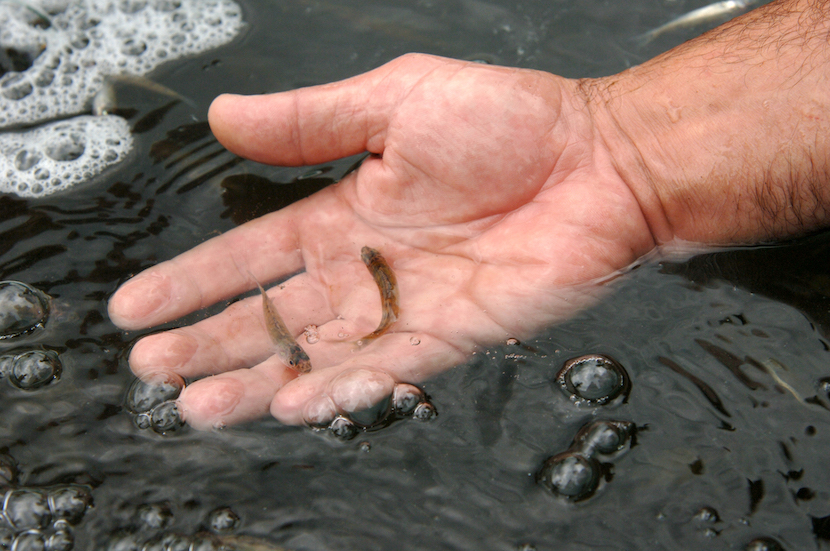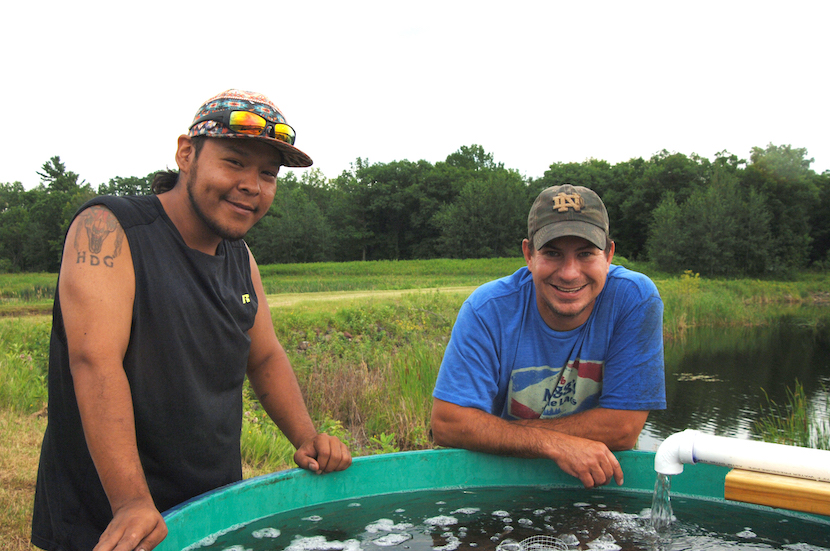
DNR's Fisheries Program stocks walleye fingerlings in lakes around the region
By Vivian LaMoore Director of Public Relations
The Mille Lacs Band Department of Natural Resources Fisheries program has come a long way since casting a line in the development of the fish hatchery in 2015. This spring, Mille Lacs Band Aquaculture Biologist Keith Wiggins-Kegg has been working closely with Aquaculture Intern Harvey Goodsky at the hatchery and giigoonh (fish) ponds. This year’s giigoonh-rearing efforts have resulted in some highly successful results so far with many months to go before winter takes hold of the rearing ponds.
The DNR launched the aquaculture (fish farming) program in 2015 by designing and building a hatchery using mainly donated equipment and by purchasing other needed equipment with a modest budget of $10,000 from the Bureau of Indian Affairs (BIA). By fall of 2017, Band biologists successfully released an estimated 3,442,000 fry into area lakes.
Keith joined the MLB DNR fisheries department in 2018. "What we’ve done in the short time I have been here is nothing short of miraculous," he said.
Keith earned his degree from Mount Hood Community College in Oregon. He left Oregon on a four-day journey pulling his boat and drove straight through to Mille Lacs. "I was so tired," Keith recalled. "It is great to work with this group of biologists and staff. They are all very supportive. We are building on the existing hatchery and really establishing some very unique concepts with significant importance.“
Keith went to work immediately using funds from the BIA to update the hatchery with new equipment. Keith removed excess tanks, engineered a new nine-bag filtration system to eliminate debris, built a new system to eliminate gas, made new tank screens to prevent fry from escaping, installed a wood heater, constructed an aeration system, and more.
Despite all of the new improvements, in the spring of 2019, the laws of nature intervened. During the final stages of the incubation phase, a passing storm overwhelmed the new filtration system. The flow was lost, causing an ogaa (walleye) fry mortality rate of 50 percent.
Despite the loss, 1,000,000 ogaa fry still survived. These fry were successfully stocked into three of the six rearing ponds and are currently 1.5 to 2.5 inches long.
Keith was mainly assisted this spring by Harvey Goodsky, the DNR's aquaculture intern. Harvey was attending Fond du Lac Tribal College fulfilling basic academic courses. He knew his ultimate goal was to gain an education and work in a field that was culturally significant such as education or language study. When he saw the aquaculture internship position open up, he said he thought it would be a good opportunity for the summer.
"I come from a very culturally traditional family. I sing and dance, my children all dance. Our Ojibwe culture is very important to me and my family. I was drawn to the job description because of the word 'culture,'" Harvey said. "I really didn’t know what to expect. But I really enjoy it. I am learning something every day. I know all of these things are important because walleye and the lake are such an important part of our culture."
Keith and Harvey have been busy this spring and summer keeping the hatchery healthy and studying specific issues that affect the health of not only Mille Lacs Lake, but other area lakes as well.
"I have assisted with sub-sampling for aquatic invasive species to work towards preventing the spread of AIS," Harvey said. "At the hatchery, I work with maintaining egg jars and have learned how to keep out ICH (a fish disease caused by the ciliate protozoan Ichthyophthirius multifiliis), fungus, and mold. The hatchery and all projects and equipment associated with it, such as jars, tanks, and filtration, have to be monitored every day." Keith, Harvey, and the fisheries team attend to the hatchery and ensure all projects are monitored multiple times a day, every day, even on weekends.
After the fertilized eggs hatch, 1,000,000 fry were stocked into three of the six rearing ponds as well as 1,000 muskie fry. Fathead minnows were also stocked into the ponds to feed the growing fish. Starting in July, fingerlings were stocked into area lakes within the 1837 Ceded Territory lakes. Stocking of the lakes and ponds will continue into the fall. Lakes that have been stocked include Mayhew, Pierz-Fish, Lehmans-Hidden, and Captive. If time allows, Shakopee, Sullivan, and Platte may be stocked as well.
The netting process has been successful. Survival rates of ogaa fingerlings after harvest can vary from 50-70 percent in the summer due to the heat; however, the fisheries team is seeing greater success having roughly a 95 percent survival rate. "I actually need 100 non-living ones so I can dissect them to study under a microscope for any invasives. But it makes me happy so many are surviving," Keith said. The invasive species studies are being conducted with help from other DNR interns as well.
The fishery team is helping to ensure sustainability of the ogaa for future generations. In addition to the Elder and youth pond in D1, they are formulating plans for a fishing pond at East Lake stocked with ogaa. The East Lake fishing pond would provide fishing opportunities to Elders and youth.
By the end of the internship, Keith explained, Harvey will have been a part of the entire ogaa-rearing process, including sampling, egg and milt harvesting, fertilization, hatching, and releasing fry and fingerlings this fall.
Harvey said he has found something he is really excited about. He is now considering a career in the environmental science field and possibly fish and wildlife conservation and biology.
"This is important to our culture. I will be able to bring what I learn back to help our community," Harvey said. "Plus, it is really cool."
For more information, visit the fishery team at an open house on Saturday, August 17, in the backyard of the government affairs office in Wahkon from noon to 3 p.m. Presentations on the fisheries telemetry study will be given at 1 p.m. and again at 2 p.m.
Photos:
Above: George Big Bear and Keith Wiggins emptied walleye fry into a quarantine tank.
Below: Harvey Goodsky and Keith Wiggins have been working at the Band's hatchery this spring and summer. The stocking process is delicate in nature, Keith said. Captured by 4-by-6-foot fyke nets, the young ogaa are transferred to a quarantine tank for 24 hours. "We need to make sure that no invasive species are introduced to the lakes and ponds we are stocking," Keith said. Keeping the young of the year ogaa isolated in fresh water will ensure filtration of any spiny water fleas and other possible invasives.

